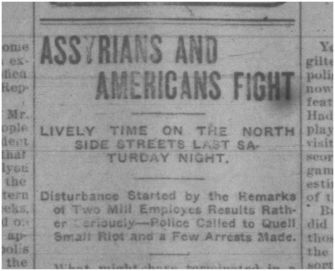
Syrians in La Crosse
(written by Barry McKnight, Archives staff)
With debate about Syrian refugees currently in the news, the Archives department recalls a prior period where Syrian refugees came to America’s shores seeking refuge and “yearning to breathe free”. In the last decades of the nineteenth century and the first decade of the twentieth, around 100,000 immigrants from the Ottoman province of Syria (what is now Syria, Lebanon and part of Jordan) came to the United States seeking economic opportunity or fleeing an oppressive government.
Most of the Syrian immigrants in those early years were self-employed as “pack peddlers”, itinerant salesmen who carried their goods on their back as they followed their routes through city streets and rural roads. Selling items like clothing, sewing supplies, shoes and razors, they were usually a welcome sight to prospective customers, especially rural ones. Relying on family connections, the Syrian peddlers established extensive networks of sellers and suppliers throughout the United States, and Wisconsin was no exception. The successful ones opened stores, often acting as suppliers to the peddlers, or as grocers.
 Syrian fruit store on 3rd St.
Syrian fruit store on 3rd St.
The first Syrian immigrants to La Crosse came as peddlers during the mid-1890s, perhaps coming from Syrian communities in Milwaukee or Cedar Rapids, Iowa. By 1900, La Crosse had a small Syrian community of 32 people, living mostly on Mill St (what is now Copeland Ave) on the North Side and in downtown La Crosse. By 1910, this number had grown to 139. The beginning of World War One in 1914, with the Ottoman Empire fighting on the side of Germany and the Austro-Hungarian Empire, would curtail further immigration.
The Syrians in La Crosse faced more than their share of prejudice and abuse. Predominately Christian, the initial language barrier and cultural differences often provoked suspicion and negative reactions towards these new Americans. The La Crosse newspapers of the time used inflammatory language and exaggeration whenever discussing the Syrians. For example, on January 5, 1905, the La Crosse Tribune reported that for the Syrians, “wrangles over trivial things are common and bloodshed is almost a daily occurrence”, something that is not borne out by police records. Newspapers frequently referred to the Syrians as “swarthy” and when quoting them, printed their statements phonetically to draw attention to their accents.

 (Chronicle, Sunday July 6, 1902) (Republican and Leader, Monday July 7, 1902)
(Chronicle, Sunday July 6, 1902) (Republican and Leader, Monday July 7, 1902)
Tensions between the Syrians and their North side neighbors occasionally led to fights, the details of which were often exaggerated in the newspapers at the time. For example, a fight erupted on July 5, 1902 between two Syrians and several “Americans”, as the newspapers referred to them. The two groups met at a public drinking fountain and racially charged insults were hurled at the Syrians. A shoving match turned into a fistfight and supporters of both groups rushed to the scene. What happened next is unclear, given the manner it was variously reported in the city’s newspapers. The La Crosse Chronicle put the fight on page one, calling it a “race riot” and placing the blame on the immigrants, whose regular “midnight orgies” were “making life miserable for citizens.” Claiming that several hundred people participated in the brawl, it talked of shots being fired and people being stabbed, details not cited in other newspapers with less lurid headlines.
 (Chronicle Sunday February 16 1902)
(Chronicle Sunday February 16 1902)
Not all viewed the Syrian immigrants negatively, however. An article in the La Crosse Chronicle from February 16th, 1902 breathlessly relates the story of how Askunder Mansoor, naturalized American and La Crosse resident, fled his native land after converting to Christianity and came to America, narrowly avoiding torture at the hands of Ottoman soldiers. The long article details, in highly romantic terms, his search for a wife, his business success and troubles with the Turkish government. His Horatio Alger-like story is offered as testimony to the opportunity awaiting hard-working immigrants on these shores.
 Saint Elias Church Christmas celebration
Saint Elias Church Christmas celebration
The children of the Syrian immigrants attended La Crosse schools alongside other children and helped their parents and grandparents assimilate to life in La Crosse. Today, the descendents of these Syrian immigrants are part of the firmament of the La Crosse community, bearing well-known local names like Monsoor, Skaff, Addis and others.
For more information regarding this community, their history and contributions to the community of La Crosse, visit the Archives department at the La Crosse Public Library.

